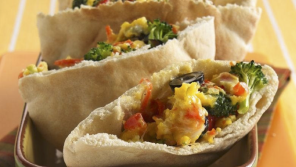 Benefits
Benefits
- Studies show high-quality protein can improve satiety, help manage weight, and prevent chronic disease.
- Eating breakfast can help stabilize hunger for the entire day, especially if it includes protein.
- Protein reduces ghrelin (hormone that tells us we are hungry) levels best and generally increases leptin activity (hormone that decreases food intake and regulates energy metabolism).
- Some of the best ghrelin suppressing foods are: skinless poultry, lean beef, fish, eggs, and fat-free Greek yogurt.
- There is no need to overload on protein at breakfast. Stick with one to three ounce equivalents. 1 ounce of each food is: 1 ounce cooked lean meat, 1 egg, 1 tablespoon peanut or almond butter, 1/8 cup nuts, 6 ounces Greek yogurt, ¼ cup low fat cottage cheese, or 8 ounces low fat milk.
Ideas & Recipes
If you like cottage cheese try:
If you like Greek yogurt or kefir try:
If you like eggs try:
If you like peanut or almond butter try:
Did you know…
- Mangos are the most consumed fruit in the world.
1 cup of sliced mangos provides 100 calories with 3 grams of fiber (a good source) and 100% of your daily vitamin C needs. It is also a good source of vitamin B6, vitamin A, and folate. (mango.org)
- The liquid part of yogurt that sometimes separates on top, the whey, contains important nutrients such as calcium, potassium, and protein.
Don’t drain it, mix it!
- By cooking in a cast iron skillet, you get the benefits of added iron to your meal.
This would be particularly helpful for vegans, vegetarians, and those deficient in iron. (foodandnutrition.org)
- What you eat and drink can impact colon cancer risk.
High consumption of red and processed meats as well as added sugars may increase the risk of colon and rectal cancer. Intake of fiber can reduce colon cancer risk. Make your meals with fruits, vegetables, whole grains, and legumes. (onlinelibrary.wiley.com)
- Avocados are a smart and tasty salad topping choice!
Why? The healthy fats from avocados help you better absorb carotenoids, antioxidants, found in many salad veggies such as spinach and carrots. Plus a quarter of an avocado adds 3.5 grams of fiber and hard-to-get vitamin E. (eatright.org)
- Veggies have protein!
1 cup of cooked spinach has 5 grams of protein and 1 cup of cooked broccoli has 4 grams of protein. (eatright.org)
- After an intense workout (intense level 60+ minutes) it’s important to refuel with fluids, electrolytes, carbohydrates and protein within 15-60 minutes.
Try these ideas: smoothie made with yogurt and frozen berries or graham crackers with peanut butter, low fat chocolate milk, and banana. (eatright.org)
- An almond is actually a stone fruit!
Examples of stone fruits are peaches, plums, apricots, and cherries. The name comes from the stone-hard covering found around the single large seed at the fruit’s core. Almonds on the tree look like small hard green peaches. Culinary experts often point to a slight almond flavor in stone fruits and that is why these fruits pair so well with almonds in recipes. (foodandnutrition.org)
- Current research reveals that too much sitting is detrimental to a person’s health, even if you engage in the recommended amount (>150 minutes per week) of moderate to vigorous activity.
Many of our current environments promote sedentary behavior. Increase your daily activity by walking more whenever you can, get up and stand or walk during work breaks or when you take a sip of water, or get a pedometer.
- Your pets should never eat raisins, grapes, macadamia nuts or chocolate.
Eating fairly large amounts of raisins and grapes can cause kidney failure in dogs. Macadamia nuts and chocolate (particularly dark or baking chocolate) can cause vomiting, upset stomach and other symptoms. (foodandnutrition.org)
By Alyssa Slater, Dietetic Intern from Purdue University
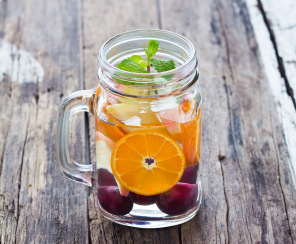 You may not realize how many calories you are consuming from your drink. One can of soda has about 140 calories and a large fountain soda has about 365 calories! A large sweet tea from a fast food restaurant can amount to 230 calories! So what can you do to reduce calories from beverages? Water is always a great option. It is the best beverage to keep you hydrated, which is beneficial for your skin, gastrointestinal system, kidneys, and overall health, and it contains zero calories. Other beverages that can be part of a healthy diet include low-fat or fat-free milk, a small glass (6oz.) of 100% fruit juice, and fruit-infused water.
You may not realize how many calories you are consuming from your drink. One can of soda has about 140 calories and a large fountain soda has about 365 calories! A large sweet tea from a fast food restaurant can amount to 230 calories! So what can you do to reduce calories from beverages? Water is always a great option. It is the best beverage to keep you hydrated, which is beneficial for your skin, gastrointestinal system, kidneys, and overall health, and it contains zero calories. Other beverages that can be part of a healthy diet include low-fat or fat-free milk, a small glass (6oz.) of 100% fruit juice, and fruit-infused water.
Try to make simple drink swaps to reduce calories including:
- Large coffee with whole milk – small coffee with 1% or skim milk
- Regular soda– diet soda or flavored water
- Sweet tea – unsweet tea or half sweet and half unsweet
- Lemonade – water with lemon
Become more aware of what is in your beverages by reading the nutrition facts label to find the amount of calories in each serving. Also, look at the ingredients list to see if your beverage has added sweeteners which will contribute to the calorie amount. Look for words such as high-fructose corn syrup, fructose, syrup, sucrose, or dextrose, and limit these beverages. By switching to lower-calorie drinks, you will often reduce the amount of added sugars in your beverage which can lead to a lower overall caloric intake to promote weight loss and a healthier lifestyle!
Check out these refreshing infused water recipes:
Orange Mint Water
- 3 large oranges, sliced
- 10 mint leaves
- 1 half gallon of water
Place mint and orange slices in a pitcher and add water. Allow flavors to blend at least two hours in the refrigerator. Pour in glasses over ice and serve garnished with an orange slice and a sprig of mint.
Cucumber Melon Water
- 1 large cucumber, sliced
- 1/4 honeydew melon, cubed
- 1/4 cantaloupe, cubed
- 1 half gallon of water
Place melon and cucumber in a pitcher and add water. Allow flavors to blend at least two hours and then serve in glasses over ice.
Frozen Fruit Water
- 2 cups frozen apple chunks, mangos, pineapple, or berries
- 1 half gallon of water
Add frozen fruit to a pitcher. Pour water over fruit and let sit at least an hour in the refrigerator. Stir to distribute fruit flavor and serve in glasses over ice.
Note: you can chop up the same kind of fruit, unfrozen, and follow same directions. You will need to use more ice when serving the unfrozen fruit-flavored water.
FODMAPs stands for Fermentable Oligo- Di- Mono- saccharides and Polys, a group of short chain carbohydrates that if eaten in excess may worsen symptoms of gas, bloating, diarrhea, or constipation in some individuals, specifically those with irritable bowel syndrome (IBS). Learn more about FODMAPs.
There can be some challenges to implementing the FODMAP elimination diet. So, here are a few tips to help!
Increase Fiber
If you are constipated while following the low FODMAP diet it will be beneficial to increase your fiber and water intake. Increase water to 64oz (8, 8oz. cups) daily. Increase fiber gradually. Here are some ways to increase fiber:
- Make sure you are eating the low FODMAP fruits and vegetables daily. You may have had to cut out some of your high FODMAP favorites such as broccoli or apples which are high in fiber, so make sure to replace them with the low FODMAP options, such as green beans and oranges. Aim for at least 3 servings of fruit (1 ½ cups) and 4 servings (2 cups) of vegetables daily.
- Choose low FODMAP whole grains: oatmeal, brown or wild rice, quinoa, popcorn, gluten free breads, pastas, and cereals made with whole grains (look for >2.5gm fiber/serving) but watch out for other added FODMAPs in gluten free products.
- Include 1 Tablespoon of ground flaxseed, chia seed, or oat bran or 2 Tablespoons of nuts (not pistachio or cashew) to foods such as oatmeal, cereals, lactose free yogurt, or smoothies.
Additional Calories
Are you underweight or are losing weight unintentionally on the FODMAP diet? Here are a few tips to help increase your calories:
- Drizzle olive oil or spread butter on your low FODMAP vegetables, grains and starches, and meats.
- Add 1-2 Tablespoons of peanut butter to your snacks or meals. Top rice cakes or crackers with peanut butter. Enjoy a banana with peanut butter. Add peanut butter to your oatmeal or low FODMAP smoothie.
- Snack on a small handful of nuts.
- Drink Ensure Live, a supplemental drink that is low in FODMAPs.
- Add an egg to your snack or meal. Look for the egg boost oatmeal recipe on this website. Enjoy hard boiled eggs for a convenient snack or to add to a salad.
- Cook your oats with lactose free milk instead of water.
- Add hard cheeses to meals and snacks. Enjoy cheese and Nut Thins crackers as a snack. Top salad, soup, or any dish with shredded cheese.
Ingredients to Avoid
Label reading is important while following the FODMAP elimination diet. Here are a few ingredients to look for and AVOID if you see them:
- High Fructose Corn Syrup (common ingredient in sodas, Kool aide, and condiments)
- Fructose
- Honey (common in cereals, breads, granola bars, peanut butter)
- Molasses (common in peanut butter, cereals, granola bars)
- Agave
- Fruit Juices
- Dried fruit (common in cereal, granola, oats)
- Inulin (Common in yogurts, alternative milks, ice cream)
- Chicory Root (Common in cereals, granola bars)
- Sorbitol, mannitol, xylitol (common in sugar free gum, syrup, jelly, candy)
- Onion (all forms) (common in salad dressings, broths, flavored rice mixes, crackers, soups)
- Garlic (all forms) (common in salad dressings, broths, flavored rice mixes, crackers, soups)
Add Flavor
Do your meals taste a little bland? Here are suggestions for flavoring your foods:
- Use spices such as cinnamon in your oatmeal or cumin in your Mexican dish.
- Use fresh or dried herbs such as basil in your gluten free pasta meal or cilantro on tacos.
- Use vinegars to liven up a dish such as squeezing lemon juice over steamed green beans, fish, or chicken. Drizzle tomatoes or a salad with balsamic vinegar. Add rice vinegar to a stir fry.
- Drizzle a small amount of oil on a dish such as extra virgin olive oil over veggies or sesame oil in your stir fry.
- Spice it up with adding ground black pepper or crushed red pepper flakes to any dish.
Try some new low FODMAP recipes
Check out these websites for ideas.
Happy New Year! Show your digestive system some love this year by making it the focus of your new year’s resolutions. See how many Digestive Health Habits (from the list below) you can check off because you are already implementing them. Are any left unchecked? Make them your new year’s resolutions for digestive health! This year, I will…
- Increase my daily water intake.
- Whether you face constipation, diarrhea, or weight gain; drinking more water is key. Aim for at least 6-8, 8oz. cups or more of water a day.
- Implement by having a water bottle with you at all times, at your desk and on the go. Not a big fan of drinking water? To change it up a bit, try adding a slice of fruit (lemon, orange, etc.), bottled fruit infused waters, or sparkling water.
- Drink less soda.
- High fructose corn syrup, artificial sweeteners, carbonation, caffeine in large amounts, calories with no nutritional value does not make for a very happy digestive system.
- For caffeine, try drinking different varieties of tea instead. Have a plan for gradually decreasing your soda intake or go cold turkey.
- Start my day with a high fiber breakfast.
- Including foods with fiber at breakfast can help regulate bowel movements, promote good bacteria in your digestive tract, and can affect your eating habits the rest of the day. Some high fiber foods are fresh fruits, oatmeal, ground flaxseeds, bran cereals, etc.
- A high fiber breakfast can be quick and convenient. Check out these videos for ideas:
- Consume probiotic rich foods and beverages.
- Increase those good bacteria in your gut for digestive health!
- Eat yogurt (with live active cultures) for breakfast or a snack with fruit and whole grain cereal. Use kefir in place of milk or yogurt in a smoothie. Add sauerkraut or kimchi to your meal. Add tempeh, a fermented soybean product, to your stir fry.
- Check out these videos for more probiotic information and recipes:
- Take more time to eat my meals.
- How fast you eat, how well you chew your foods, how relaxed you are at meal times all affect your digestion.
- The hormones in our digestive tract that tell us we are full and to “stop eating” are triggered by the presence of food and are located further down in our digestive tract. It takes at least 15-20 minutes for our gut to tell our brain we are full. This is why is it so important to enjoy a small meal over at least 20 minutes, to prevent overeating.
- Some tips to eat slower include: set out at least 30minutes in your schedule to eat a meal; avoid other distractions such as TV; chew on your veggies first; drink water or set down your fork between bites; eat from a smaller plate.
We wish you and your digestive system a happy and healthy 2015!
Happy Holidays! Enjoying delicious food is a big part of the holiday season. Those with celiac disease or non-celiac gluten sensitivity may find it difficult to enjoy celebrations where food is involved due to having to avoid foods and beverages with gluten. Celiac disease affects at least 1% of Americans, or nearly 3 million people in the United States. It is estimated that 1-6% or up to 18 million Americans have non-celiac gluten sensitivity. You are not alone when it comes to the challenges of avoiding gluten and enjoying social events over the holidays.
Here are a few tips to help you enjoy the holiday season on a gluten free diet:
- Keep the focus on things other than the food. Enjoy catching up and socializing with family and friends. Enjoy the holiday decorations, warm fireplaces, and white snow. Enjoy giving and receiving gifts, helping those in need, and playing games.
- Be prepared. Make a couple gluten free dishes in advance and bring them to the party to share or make a gluten free plate for yourself to bring along.
- Have fun with trying new gluten free recipes. There are so many to choose from and they can be simple and delicious. Try some of the gluten free recipes below!
Gluten-free Recipes
- Quinoa Pizza Bites: Pizza ingredients combine to make a delicious bite size appetizer, enjoyed by adults and children.
- Edamame, Feta, and Cranberry Salad: Simple ingredients with bold flavors come together in no time for this festive salad!
- Baked Oatmeal: Perfect for breakfast or brunch; you can prepare it the night before and pop it in the oven in the morning! Top or add in other fruit as desired.
- Slow Cooker Jam and Ginger Pork: This effortless recipe is filled with flavor and would be great paired with wild rice and roasted green beans. *Use gluten free soy sauce.
- Pretzel Turtle Bars: Salty pretzels, sweet dark chocolate, and crunchy pecans melt together for this delicious dessert that will be enjoyed by all!
I hope you enjoy these recipes and have a wonderful holiday season!
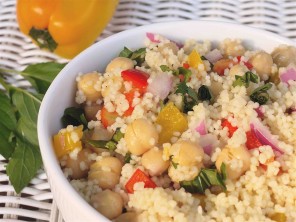
A healthy lunch can be delicious, convenient, low cost, and energizing. Read to find out more!
Benefits of making your own lunch verses eating fast food or carry- in include:
- Increased awareness of ingredients in the meal and nutritional information such as calories
- Personalized portions
- Special requests fulfilled
- Money and time savings
Follow these simple steps to pack a balanced satisfying lunch:
- Keep what’s in your box within your calorie range. On average between 300-450 calories. Look at nutrition facts labels or utilize a calorie tracker app or website.
- Include:
2-3oz. lean or low fat protein (such as chicken breast, turkey, canned tuna or salmon, tofu, 1 egg, 6oz. Greek yogurt, ½ cup beans or legumes)
+
1-2 servings complex carbohydrates (such as ½ cup brown rice, whole grain pasta, farro, quinoa or barley; 1 slice whole grain bread, small whole grain tortilla, ½ sweet potato with skin)
+
Plenty of vegetables and/or fruits (any you like or in season)
+
1 serving of a healthy fat (2 Tbsp. nuts or seeds, ¼ avocado, 1 tsp. olive oil, 1oz. cheese)
- Pre-prep your lunch for the week or two ahead by taking just an hour of your time. Make a batch of 2 or more different dishes or recipes. Store some in the fridge that you will be using within 4 days and store the rest in the freezer.
Lunch Box Ideas:
| Name |
Protein |
Complex Carb |
Veggies/fruits |
Added fat |
Calories |
| Lite n’ Leafy Salad |
½ cup canned beans, rinsed and drained (favorite variety) |
½ cup cooked quinoa |
2+ cups leafy greens/ 2 Tbsp. dried craisins/ 2 Tbsp. chopped scallions |
2 Tbsp. light vinaigrette dressing |
= 330(add a 100 calorie yogurt cup) = 430 |
| Directions: Make 4 servings. In medium bowl, mix 2 cups rinsed and drained beans, 2 cups cooked and cooled quinoa, ½ cup dried craisins, ½ cup chopped scallions, ½ cup light vinaigrette dressing. Store in fridge. Each day, in an individual container, measure 1 cup quinoa/bean mixture on top of 2 cups mixed greens and place in lunch box. |
| Warm Whole Grain Salad |
2oz. tuna or salmon |
1/2 cup cooked farro |
1 ¼ cup chopped and sautéed kale, broccoli, mushrooms, onions |
1 tsp. olive oil, 2 Tbsp. feta, salt and pepper |
= 300(add 1 medium fruit) = 370 |
| Directions: Make 4 servings. In medium skillet add 4 tsp. olive oil, sauté 2 cups chopped broccoli, ½ cup chopped mushrooms, ½ cup chopped onion, 2 cups chopped kale until kale just starts to wilt. Season with salt and pepper to taste. In 4 individual containers add ½ cup cooked farro, 1 ¼ cup veggies, 2oz. tuna or salmon, and sprinkle with 2 Tbsp. feta cheese. Refrigerate. Add to lunch box; reheat 1 minute. |
| Personalized Frozen Burritos |
½ cup chopped cooked chicken breast or beans |
8 in. whole wheat tortilla |
1/3 cup chopped lightly sautéed bell peppers, onions, etc., 1 Tbsp. salsa |
2 Tbsp. shredded Mexican cheese blend |
= 270(add ½ cup baby carrots + 2 Tbsp. hummus) = 350 |
| Directions: Make 4 servings. In medium skillet lightly sauté 1 ½ cups chopped bell peppers and ½ cup chopped onion. Season with Mrs. Dash fiesta lime blend. Top 1 tortilla with ½ cup chopped cooked chicken breasts or beans, 1/3 cup veggies, 1 Tbsp. salsa, 2 Tbsp. cheese. Fold burrito and wrap in ceran wrap. Freeze. Add to lunch box and reheat 2 minutes. |
| Comforting ½ Soup ½ Sandwich |
1 ½ Tbsp. peanut butter |
1 slice whole grain bread |
1 cup low sodium tomato or vegetable soup. Berries or banana slices |
(Peanut butter) |
= 330(add 1 string cheese) 400 |
| Directions: Spread 1 ½ Tbsp. peanut butter on half of bread slice, top with ¼ sliced banana or 1/3 cup berries, then other ½ of bread slice. Enjoy with 1 cup low sodium canned soup such as Amy’s chunky tomato bisque, minestrone, or lentil vegetable. |
What will your lunch box hold this week for a healthier you?
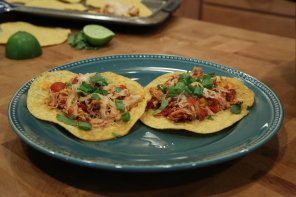
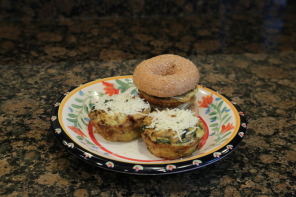

Eating well-balanced meals made at home from less processed foods is part of a healthy lifestyle. Busy schedules and lack of ideas are just a couple of things that stop us from enjoying these well balanced meals. Preparing larger batches of food in advance, portioning them out, and storing for later can save you money and time and help you achieve your health goals. First, pick a day to meal prep and plan on prepping this same day weekly or bi-weekly (put it in your calendar!). Next, plan out what you will prep. You can start with 1 thing or go all out and prep for the whole week. Below are suggested foods to prep and a few delicious big batch recipes.
- Pre-chop and portion vegetables. Store at eye level in your fridge or freezer so they are easily accessible and visible.
- Be prepared for packing healthy lunches by slicing or chopping bell peppers, cucumbers, tomatoes or any other vegetable you enjoy and store in individual containers. Add these to salads, sandwiches, wraps or throw in just as they are to enjoy with a light dip.
- Easily create a healthier dinner by including more vegetables. Pre-chop vegetables such as broccoli, zucchini, squash, onions, bell peppers, etc. Quickly add to a skillet, steam in a pot, or roast in the oven.
- Get your lean protein ready for the week.
- Bake or Grill chicken breasts to store in fridge 3-4 days. Leave whole, shred, and chop to utilize in various dishes.
- Hard boil a dozen eggs to store in fridge up to 1 week. Enjoy as a snack, slice for a sandwich or top on a salad.
- Cook lean ground meat (>90% lean)to store in fridge 3-4 days. Add to pasta sauce, use for tacos, or make a big batch of chili.
- Cook a large batch of dried beans to store in fridge 4-5 days. Add to a pasta dish, soups, salads, tacos, etc.
- Make your own frozen burritos:
Whether you eat them for a convenient breakfast, lunch, or dinner, by making them yourself you can personalize, and reduce the sodium and fat compared to what a store bought burrito would have.
How to prepare: choose a lower calorie 8 in. whole grain tortilla. Gather and prep your ingredients: a protein, lots of veggies, salsa or other topping. Assemble. Wrap up in saran/cling wrap and place in plastic bags. Freeze. Pull out and reheat in microwave any time.
Try out these suggestions:
Breakfast: 8 in. whole grain tortilla + 1 scrambled egg or 2 egg whites + chopped and lightly sautéed bell peppers and spinach + favorite salsa
Lunch: 8 in. whole grain tortilla + black beans + sautéed bell peppers, onions, mushrooms + low fat shredded cheese + chili powder
Dinner: 8 in. whole grain tortilla + shredded chicken + sautéed veggies of choice + sauce (BBQ, light Italian dressing, salsa, teriyaki)
- Make your own energy bites, granola bars, and granola
You can make them cheaper than you can buy them! They also won’t have any ingredients you don’t want in there. Make a large batch that can last you 2 weeks! Freeze individual portions and pull out to take with as a snack for the day. Try my favorite recipes below:
Dark chocolate cherry energy bites: http://www.irunonnutrition.com/2013/07/19/dark-chocolate-red-tart-cherry-energy-bites/
5 ingredient granola bars: http://minimalistbaker.com/healthy-5-ingredient-granola-bars/
Toasted cinnamon nut granola: http://www.sweetlavenderbakeshoppe.com/2012/10/autumn-granola_12.html?m=1
- Try this slow cooker chicken tostada recipe for dinners this week. http://www.youtube.com/watch?v=pWjdU66KsOA
- Make these omelet muffins for a grab and go breakfast. https://www.youtube.com/watch?v=ohuc_gipwsg
- Prep this yogurt apple salad; would be a great side for lunch. http://www.youtube.com/watch?v=B_2N5HRXe0E
I encourage you to start with 1 day and 1 item or recipe to prep for the week. I hope you enjoy the recipes!

5 or more servings of fruits and vegetables
- Rich in vitamins, minerals & fiber. Eating plenty each day can reduce your risk of cancer, heart disease and stroke and help you achieve a healthy weight. Eat a variety of colors, especially dark green, red, and orange. Enjoy them raw, steamed, roasted, grilled, or sautéed.
4 (8oz.) glasses of water
- Drink plenty of water each day to keep you healthy and hydrated. Water regulates body temperature, carries nutrients, removes waste, and cushions joints, organs, and tissues. Pick a favorite water bottle to keep with you during the day and on the go. Squeeze a lemon or orange in your water for a citrus kick!
3 good laughs
- Laughing promotes the release of endorphins to your brain, helping you feel better and have a positive attitude. There is no limit to laughing, 3 may be a good place to start.
2 hours or less of screen time
- Spend 2 hours or less each day in front of the TV or on a computer. Be physically active instead!
1 hour of physical exercise
- Move your body with physical activity 1 hour each day – walk bike, swim, dance, run… Pick activities that you enjoy and that fit your lifestyle. You can break it up into 15 minute increments throughout the day.
+8 hours of sleep
- Re-energize your body with 8 hours or more of sleep. This amount influences your performance, mood, and health.
If you can checkmark the above 54321+8 tips each day, you are on the path for a healthy enjoyable future! If there are one or a few areas that you are not achieving on a daily basis, I encourage you to think about all the things that keep you from achieving them, brainstorm as many solutions as possible, and then implement those solutions.
Get your friends, family, and co-workers to do this with you! You can keep each other accountable, encourage each other, brainstorm solutions, and enjoy life together.

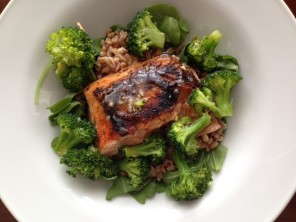
What are those foods that always make it on your weekly grocery list? Eggs, milk, bread…
Below are 7 foods worth stocking up on. They each have unique nutritional benefits and can be a great part of a balanced diet. They can be conveniently utilized in various meals and snacks and are budget friendly!
Sweet Potatoes (store in a cool dry place up to 1 week)
Nutritional highlights: Excellent source of Vitamin A important for normal vision, the immune system, reproductive health and helps many of our organs work properly. Vitamin A is a fat soluble vitamin so utilize a small amount of a healthy fat when cooking. Plus: a great source of fiber and potassium.
Ways to enjoy:
Salmon (fresh, frozen, canned, packaged)
Nutritional highlights: Excellent source of Poly-unsaturated omega 3 fats (EPA and DHA) important for heart health, brain development and function, and decreasing inflammation. Plus: a great source of protein! Check out the Monterey Bay Aquarium Seafood Watch tool to learn the best salmon to choose.
Ways to enjoy:
Frozen Berries (store in freezer up to 4 months)
Nutritional highlights: Packed with phytochemicals, fiber, vitamin C, potassium, and folate, berries are a nutritional powerhouse. Utilize fresh when they are in season, but frozen berries can be utilized year round and are just as nutritious.
Ways to enjoy:
Chickpeas (low sodium or no salt added canned)
Nutritional highlights: Excellent source of protein and fiber, both important for controlling hunger, promoting a healthy body weight, and controlling blood sugars. 1 serving is a ½ cup and provides 6 grams protein and 7 grams fiber.
Ways to enjoy:
Oats (quick cooking, steel cut, old-fashioned)
Nutritional highlights: Excellent source of soluble fiber for healthy cholesterol and blood sugar levels. Plus: a good source of protein and iron.
Ways to enjoy:
Quinoa
Nutritional highlights: A gluten free whole grain that is a complete source of protein. Plus: a good source of fiber, iron, and calcium. Make sure to get pre-rinsed quinoa and give it a quick rinse before cooking to remove the slightly bitter natural coating.
Ways to enjoy:
Bananas
Nutritional highlights: Excellent source of potassium important for blood pressure, heart health, and helps many other organs work properly.
Ways to enjoy:
 Benefits
Benefits
 You may not realize how many calories you are consuming from your drink. One can of soda has about 140 calories and a large fountain soda has about 365 calories! A large sweet tea from a fast food restaurant can amount to 230 calories! So what can you do to reduce calories from beverages? Water is always a great option. It is the best beverage to keep you hydrated, which is beneficial for your skin, gastrointestinal system, kidneys, and overall health, and it contains zero calories. Other beverages that can be part of a healthy diet include low-fat or fat-free milk, a small glass (6oz.) of 100% fruit juice, and fruit-infused water.
You may not realize how many calories you are consuming from your drink. One can of soda has about 140 calories and a large fountain soda has about 365 calories! A large sweet tea from a fast food restaurant can amount to 230 calories! So what can you do to reduce calories from beverages? Water is always a great option. It is the best beverage to keep you hydrated, which is beneficial for your skin, gastrointestinal system, kidneys, and overall health, and it contains zero calories. Other beverages that can be part of a healthy diet include low-fat or fat-free milk, a small glass (6oz.) of 100% fruit juice, and fruit-infused water.





